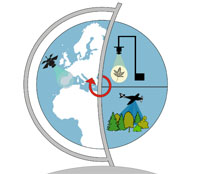Home
During the last decades, remote sensing has provided essential information on the spatial and temporal variation of land surface properties. It has contributed to the estimation of important biophysical and biochemical variables. So far, empirical approaches based on vegetation indices (VIs) have been successfully applied and have provided a satisfactory level of accuracy for estimating important vegetation biophysical parameters (e.g. LAI, leaf water content, chlorophyll, fractional vegetation cover, biomass, etc). However, such methods require a reliable reference dataset to calibrate empirical formulas on different areas and also to validate the estimations, especially those generated at regional and global scales. In fact, validation remains as one of the scientific challenges in the field of remote sensing. The assessment of errors and potential biases in satellite global products by comparison with field measurements is critical since many of the global models are based on these estimations.
Clearly a special effort has to be made in the quantification of the uncertainty associated with the estimation of vegetation parameters at different spatial scales. Furthermore, the estimation of vegetation parameters using remote sensing has been generally based on a few spectral bands, the most commonly available in commercial sensors, with a consistent under-exploitation of the full spectral range available in new hyperspectral sensors. New approaches based on the inversion of radiative transfer models represent a challenging opportunity for estimating vegetation parameters from data with high spectral resolution.
The Biospec project proposes to cover those aspects by applying a scaling-up methodology to the estimation of relevant vegetation parameters that will help validate remote sensing products at different spatial scales in a Mediterranean environment. Empirical as well as physical based models (Radiative Transfer Models) will be used to derive biophysical parameters from leaf to ecosystem level. Those estimations are key inputs for global, regional and local models of natural ecosystem processes (e.g. models of carbon fluxes). A proper characterization and estimation of biophysical parameters of vegetation is a key aspect to understand water and carbon fluxes at the global scale. Therefore, a specific project goal will be to analyze relationships between remote sensing estimation of those parameters and flux measurements obtained at selected sites in

